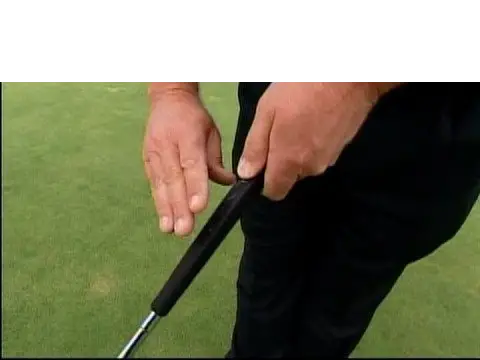Golf seems a very straightforward game when you only watch other people playing it, doesn't it?
But in reality, the situation is quite different. Yes, there are various techniques that help people master this game and be more professional every day.
However, if you are new to golf, you may not know that practice is not the only thing that can affect your outcome.
Actually, it all starts with gripping your club. If you've observed golfing pros in action over the years, you'll have noticed that they employ a myriad of distinct putting grips, each tailored to suit their individual styles and preferences.
Today, we are going to review the Pencil Grip, the Claw Grip, and the Cross-Handed Grip.
So, we aim to unearth the nuances, advantages, and intricacies that can significantly impact your putting game.
1.The Pencil Grip

First of all, let's talk about the pencil grip. Imagine holding a pen or pencil – the grip you instinctively adopt while writing a note or sketching a thought.
The Pencil Grip in putting mimics this very concept. The thing is that in this grip, the right hand cradles the putter just as it would grip a writing instrument.
This strategy underlines a certain finesse and control that can be likened to the precise strokes of an artist's brush on a canvas.
One of the key benefits of the Pencil Grip is its ability to restrict excessive movements of your wrist.
A steady and controlled stroke is critical in putting, and this grip encourages just that. By keeping the wrists in a fixed position, golfers can unfailingly attain the excellent pendulum-like motion that is the hallmark of an effective putting stroke.
Nonetheless, mastering the Pencil Grip demands patience and training. The transition from a traditional grip to this method might feel awkward initially, but with diligent effort, it can become a potent weapon in your putting arsenal.
2.The Claw Grip

Intriguingly named, the Claw Grip stands out as one of the more uncommon putting techniques, frankly speaking.
Let us explain how it works. Here, the right hand takes on the shape of a claw and holds the putter between the middle fingers.
This extraordinary grip has gained popularity for its ability to promote stability and decrease tension in your wrists.
So, we can conclude that it is quite convenient because you do not feel any pressure in your arms.
The Claw Grip enables golf players to minimize the involvement of the wrist joints during the putting stroke. It's akin to using a hingeless lever with the wrists locked in a neutral position.
This immobilization of the wrists allows for a consistent and trustworthy pendulum motion, greatly enhancing control and precision.
Thus, those people who struggle with excessive wrist action often find solace in the Claw Grip.
Try it if you are new to this game and can't deal with physical pressure yet. It's a technique that can be a game-changer when it comes to those nerve-wracking short putts where accuracy is paramount.
3.The Cross-Handed Grip

Finally, we have gotten to the last grip that we are reviewing today. It is called the Cross-Handed Grip.
Maybe you have also heard of this technique as the "left-hand low" grip. It resembles the classic overlapping putter grip but with a vital twist – the hands are switched, with the left hand now taking the lowest position on the grip.
This reversal of hand placement has a profound influence on the mechanics of the putting stroke.
One of the main advantages of the Cross-Handed Grip is its potential to eliminate unwanted wrist action.
For golfers who tend to 'break' their wrists during the stroke, causing inconsistency in distance control, this grip can be a revelation.
By placing the left hand lower, it restricts the freedom of the lead wrist, creating a more straightforward and repeatable motion.
What is more, the Cross-Handed Grip frequently promotes a smoother transition from the backswing to the forward stroke, fostering better timing and rhythm. This can be especially beneficial on fast greens where precise control is imperative.
A few words to conclude
Well, while these three putting grips – the Pencil Grip, the Claw Grip, and the Cross-Handed Grip – each have their unique merits, they still share a common goal: to enhance the golfer's control and consistency on the greens.
Regardless of the grip you select, there are basic principles that every golfer should bear in mind when it comes to putting.
The putting stroke, at its essence, involves a subtle rocking of the shoulders with minimal involvement of other body parts.
Any undue wrist action can spell disaster for consistency in putting distances. Therefore, the quest for the perfect putting stroke often begins with the understanding that the wrists must remain steadfast and unyielding.
Please remember that what works wonders for one golfer might not suit another, which highlights the beauty of golf as a highly individualistic sport!

Enrique Martínez Luque
Enrique Martínez Luque is the Argentina-based golf expert and professional writer. He built his career in the world of golf taking a number of positions. Enrique was the manager of a golf club, director at a federation level, an agent for professional golfers and director institutional relations on the Argentinian Tour. Assissted the professional golfers on major tours for almost 20 years. Worked as the press officer of national and international golf tournaments.
Follow me


